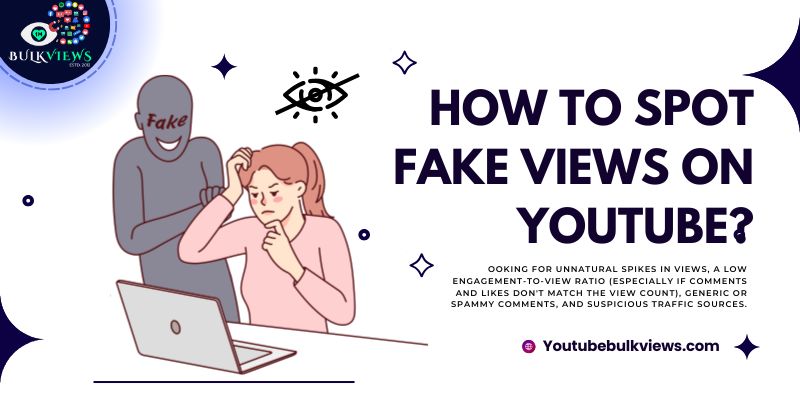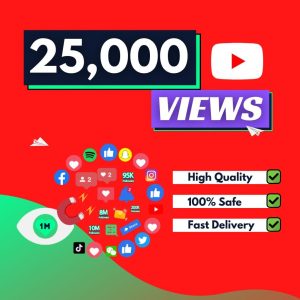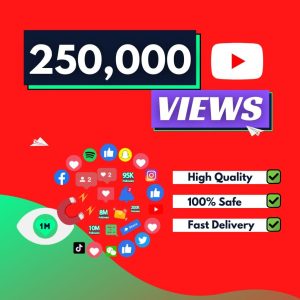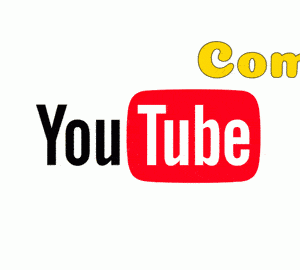How to Spot Fake Views on YouTube?
Learn how to spot fake YouTube views in the U.K. 🇬🇧 Identify fake traffic, sudden spikes, and low engagement safely by looking for unnatural spikes in views, a low engagement-to-view ratio (especially if comments and likes don’t match the view count), generic or spammy comments, and suspicious traffic sources.
YouTube views show how many people have watched a video. But not all views are real. Some are fake, created by bots or click farms. Knowing how to spot fake views helps you stay safe and keep your channel trusted. Growing a YouTube channel in the U.S. is challenging. Many creators rely on YouTube Bulk Views to buy original YouTube views safely and effectively.
Fake YouTube views are artificially inflated view counts that are not from actual human viewers and are obtained through non-organic methods such as bots, automated scripts, or click-farms. You can identify fake YouTube views by looking for a poor engagement ratio (high views with low likes/comments), inconsistent view count spikes, or comments that are generic, repetitive, or irrelevant to the video. Yes, buying fake views is illegal in the U.S. The Federal Trade Commission (FTC) treats fake views as a form of false advertising or deceptive marketing, especially when they’re used to mislead viewers or gain profit dishonestly. YouTube also bans fake traffic under its Terms of Service, which means your videos or channel can be suspended or removed if caught. Yes, fake views can severely affect monetisation by leading to video demonetisation, channel termination, and permanent bans for violating YouTube’s Terms of Service. YouTube’s system automatically detects fake or non-organic traffic. When fake views are found, they don’t count toward watch time or ad revenue, and your account’s trust score drops sharply. The safe way to boost YouTube views is by creating high-quality, engaging content and using strategic promotion methods like YouTube SEO, social media marketing, and collaborations.How to Spot Fake Views (FAQ)
🚩 1. Watch the View-to-Engagement Ratio
If a video has 100K views but only 20 likes and 5 comments, it’s suspicious. Real viewers interact — they like 👍, comment 💬, or share 🔁. Fake ones don’t.
📉 2. Check Sudden Spikes in Views
If views jump overnight from 1K to 100K without trending, it might be a sign of paid or fake views. Real growth is usually steady and builds over time.
⏱️ 3. Notice the Watch Time
YouTube Analytics shows average watch duration. Fake views usually last just a few seconds. Real viewers watch longer — especially for interesting videos.
🌍 4. Analyse Traffic Sources
Real views often come from:
YouTube search 🔎
Suggested videos 🎥
Social media platforms (Facebook, Instagram, X, etc.)
If most traffic comes from unknown external sites or suspicious regions, it might be fake.
🇬🇧 In the U.K., look for normal patterns like search and suggested traffic.
🇺🇸 In the U.S., you’ll often see traffic from Google Discover or social media shares.
🇪🇸 In Spain or 🇲🇽 Mexico, check for regional trends and languages used in the comments.
🧾 5. Low Retention Rate
Fake views lower your audience retention. If the average view duration is under 10 seconds for a 5-minute video, that’s a clear warning.
🛑 6. Check Channel History
Channels that suddenly gain millions of views on a few videos — while older ones stay low — might be using fake-view services.
🧠 7. Use YouTube Analytics Tools
Use trusted tools like:
YouTube Studio (official)
Social Blade 📊
VidIQ or TubeBuddy ⚙️
These help detect irregular patterns and confirm real engagement.
✅ 8. Buy Views Safely (If Needed)
If you want to promote your video, buy from trusted marketing providers like YouTubeBulkViews.com. They use real promotion methods — not bots — and comply with YouTube’s safe growth standards.
💬 Final Word
Spotting fake views is about balance. Real growth takes time and effort, but it builds reputation and monetisation potential. Stay transparent, use analytics, and choose safe promotion methods for genuine results.














E complicado descobrir visualização reais de visualizações compradas ou bots, geralmente quando o vídeo tem muitas visualização e poucas curtidas pode ser sinal de bots
Great article! It’s surprising how many channels still rely on fake views to boost their numbers. I appreciate the practical tips on checking audience retention and engagement metrics — it really helps separate genuine growth from artificial boosts. Authentic content always wins in the long run!